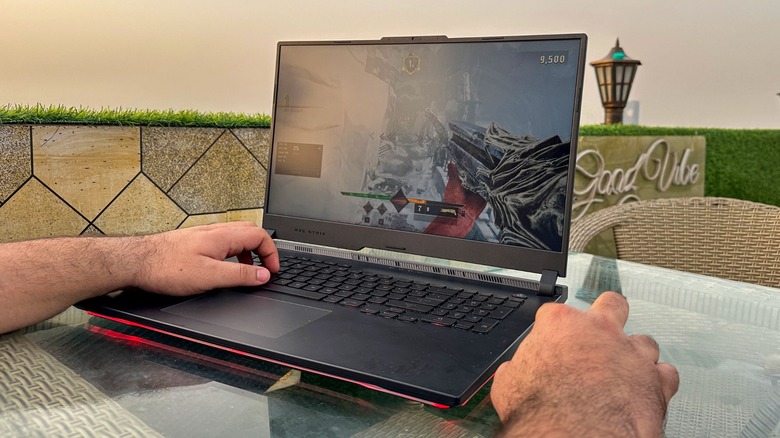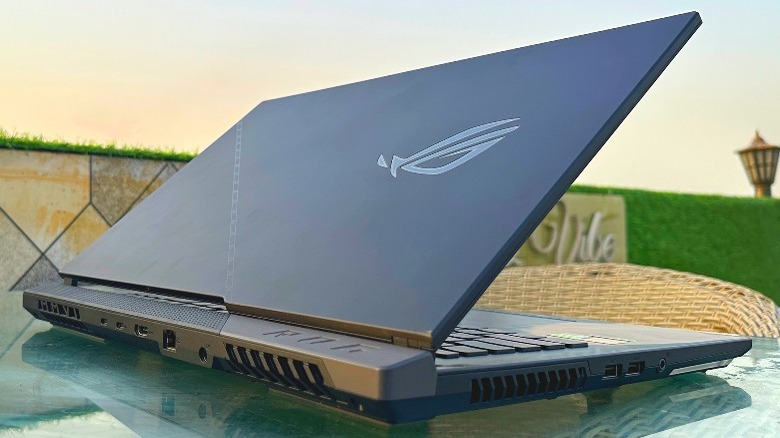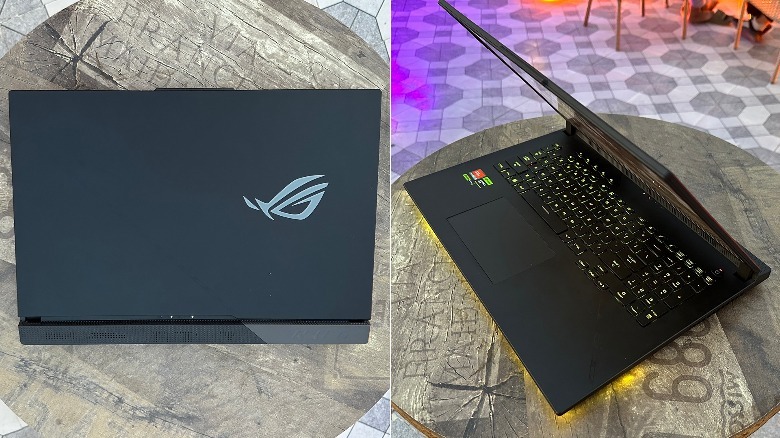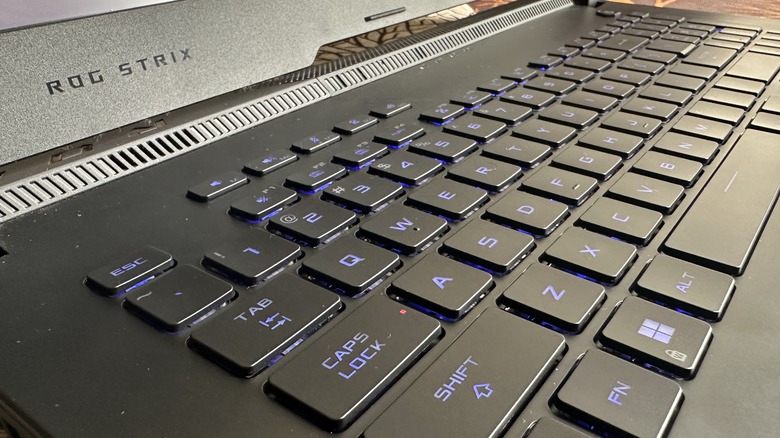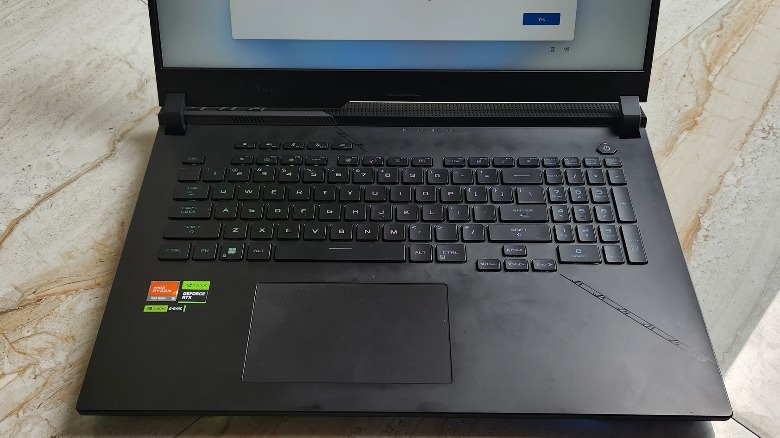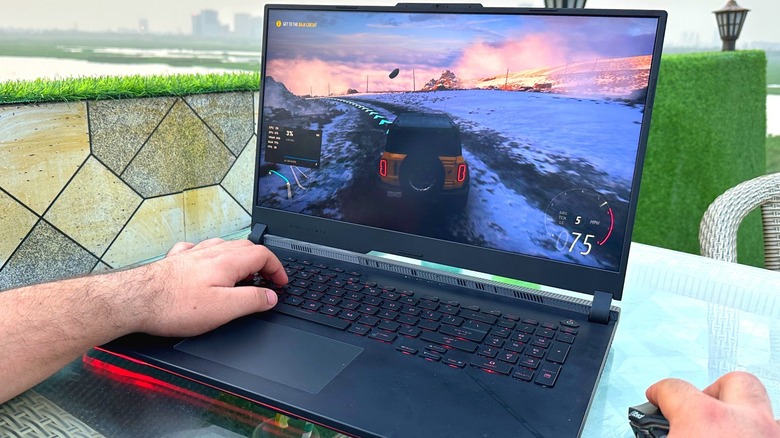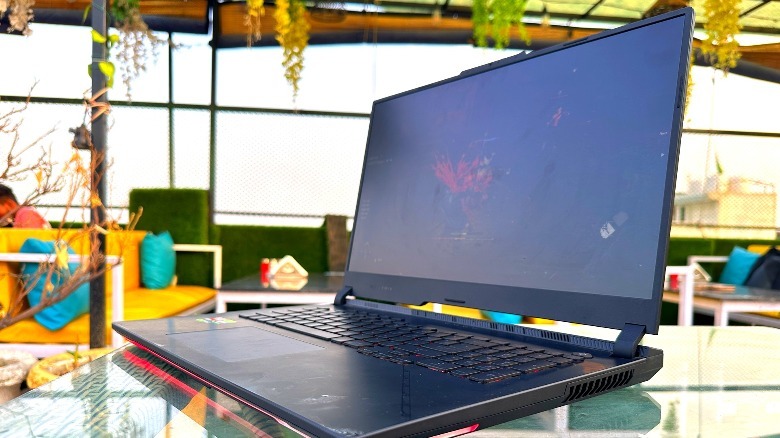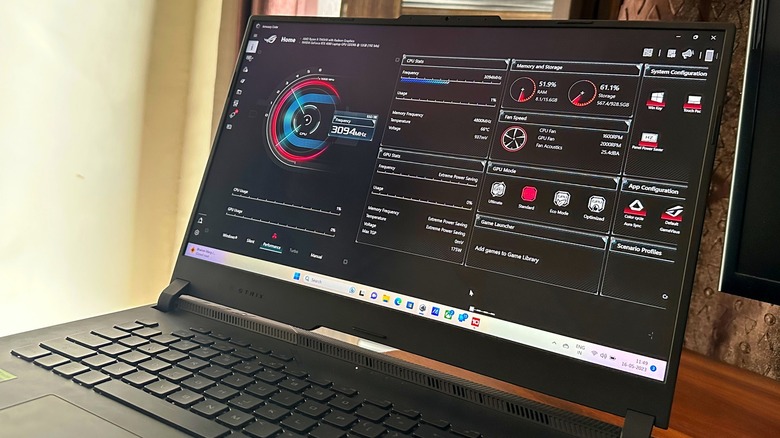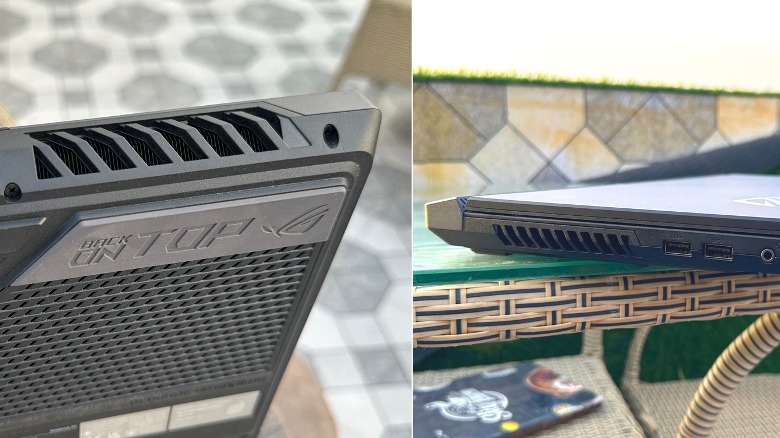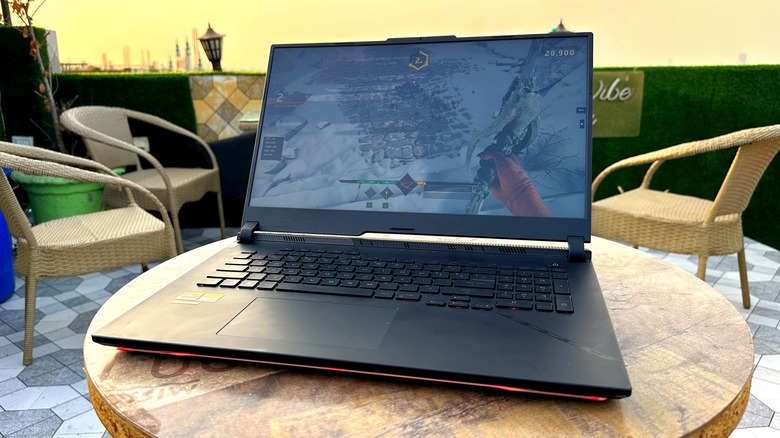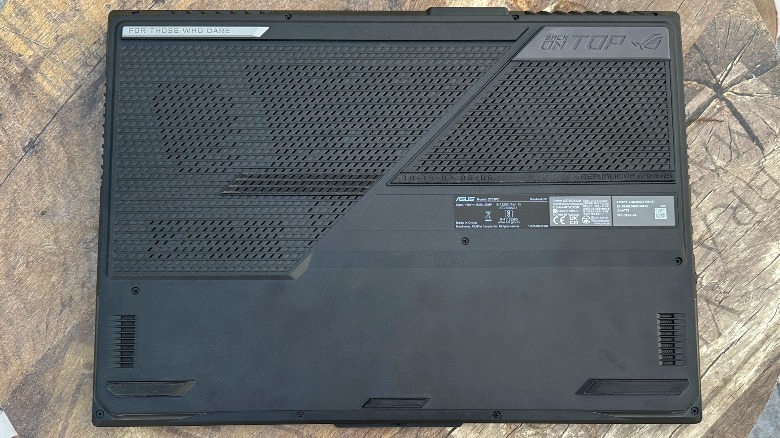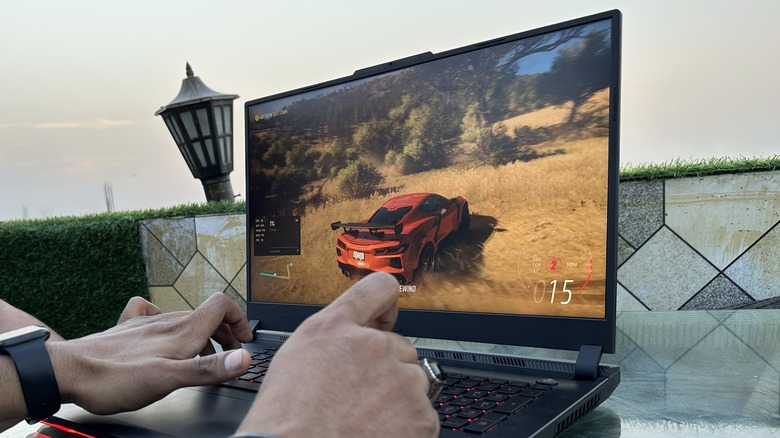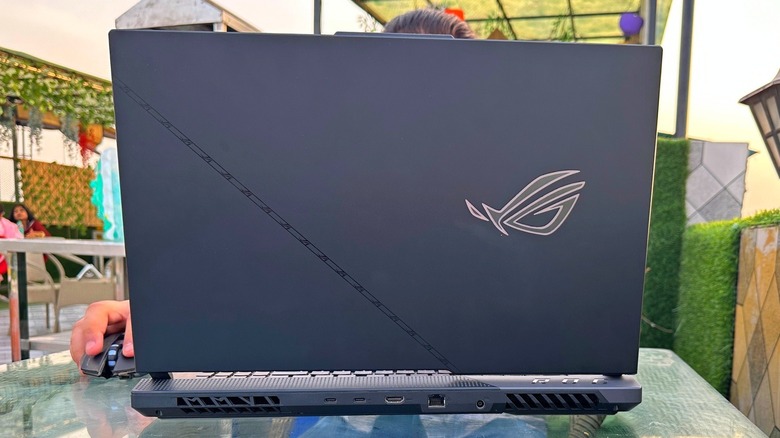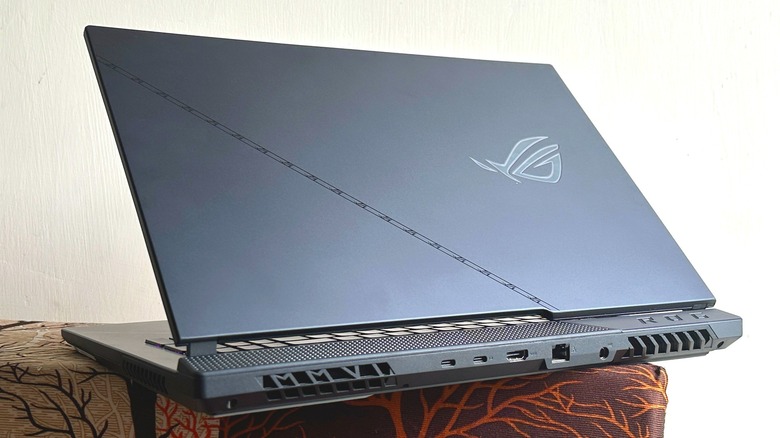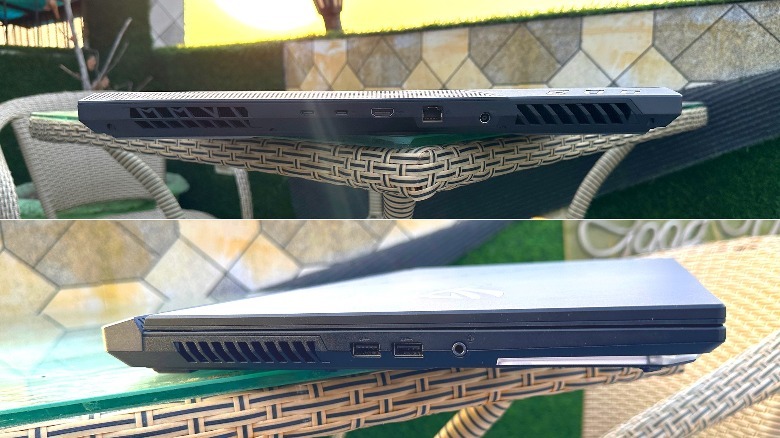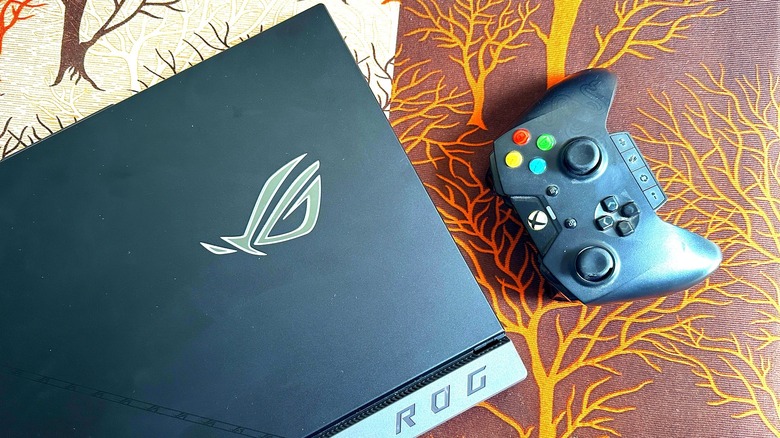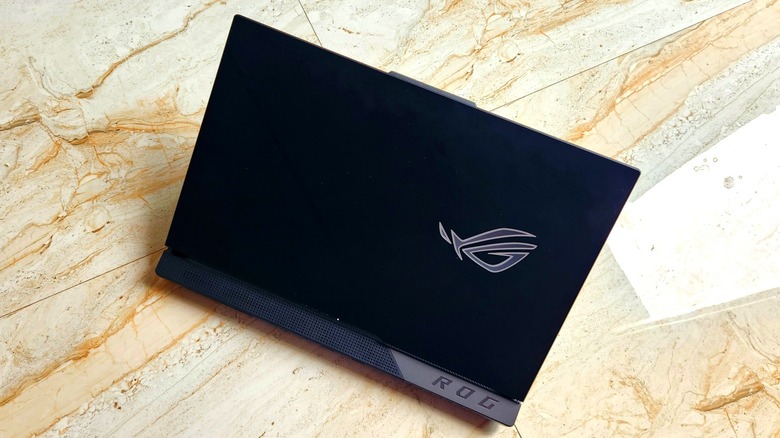Asus ROG Strix Scar 17 (2023) Review: A Gaming Notebook Made To Be The Best
- Top-end performance
- A surprisingly rewarding keyboard
- Fast screen tailor-made for gaming
- Good value for the raw firepower
- Generous I/O port situation
- A little bit of flex in the plastic chassis
- Prone to smudging
- The ROG Strix line-up needs a design refresh
- Asus has better screens to offer in this bracket
We may receive a commission on purchases made from links.
Asus kicked off 2023 with an aggressively fresh line-up of gaming laptops packing the latest silicon from Intel, AMD, and Nvidia across its ROG family. This review covers the recently launched ROG Strix Scar 17, an iterative upgrade that combines the 16-core AMD Ryzen 9 7945HX processor with the might of Nvidia's GeForce RTX 4080 mobile graphics. Asus paired those beefy innards with a 240Hz QHD screen, which is not the fastest out there, but still among the best you can get if a top-class refresh rate for high-FPS gaming is your primary concern.
Priced at $2,899, this machine is not exactly cheap, but it still firmly retains its position as the best value you can get from a mobile battle station that has AMD's flagship CPU ticking inside. It also marks the entry of AMD in a segment where a majority of gaming laptops are rocking 13th gen Intel silicon at a rather steep price. Asus is keeping things modest in the design department and has cut a few corners too, but the overall result is a fiercely competent gaming laptop that can stand its own against the best out there. Asus provided a ROG Strix Scar 17 (2023) for the purpose of this review.
A familiar design
Asus is serving a familiar design package as last year's ROG Strix Scar 17, with a few small modifications. It's still a slick, all-black affair with matte finish all across, and eagerness to get smudged. The machine needed some wiping after every usage session, especially on the deck area, and worse if you got sweaty palms. The only aspect breaking the monotony is the ROG-branded plate cap in the top-right corner and the dotted pattern on the remaining area resting behind the display lid.
Toying with the looks of the hinge rib offers a neat contrasting effect to the otherwise plain looks of the top lid, which only has the backlit ROG logo outlined in white and a thin line matching the corner plate's angular aesthetics. To justify its gaming laptop credentials, you will find a glass-like transparent RGB light strip running underneath the front deck edge, which also extends to the sides.
There is a little bit of flex to the lid, which is noticeable when you lift open the screen, but the hinge mechanism holds things tight without any concerning sideway movements or creaking. The arched hinge is tighter and offers a more reassuring experience compared to the damage-prone hinge engineering on some ROG Zephyrus laptops that we've tested in the past. Overall, the ROG Strix Scar 17 is serving a design that won't turn many heads, but the conservatively familiar looks are still pleasing to the eyes.
An uncharacteristically good keyboard
This ROG Strix Scar 17 review was initiated with a performance-first approach — and it came out swinging with a keyboard that was surprisingly robust and fine-tuned. It's not a low-profile mechanical keyboard, but the membrane engineering underneath is one of the finest implementations I've ever used on a laptop, and almost in the same league as the venerable Lenovo ThinkPad keyboard.
The keycaps have a subtle inward-curved profile and flaunt a matte surface. Of course, you can also customize the backlight underneath with per-key RGB controls using Asus' pre-installed Aura Sync software. The typing experience on this keyboard is fantastic. The keys offer just the right amount of resistance, around 2mm worth of vertical travel, acceptable upward feedback, and balanced spacing. Right from the start, it was almost natural to punch articles at the usual typing pace.
While gaming, any mushy character to the keys wasn't felt. A few colleagues that gave this keyboard a try also liked the execution. The dedicated num pad is a bonus, and five additional function keys at the top are also of great convenience. These can also be customized as macro keys or to launch specific apps. The only downside is the deck material, which feels good to touch, but has a bit of flex to it. The keyboard deck, especially the area right above the trackpad, also pushes down a little. It's not exactly flimsy, but you will certainly notice it.
A fast display that gets the job done
The ROG Strix Scar 17 configuration tested for review serves a 17.3-inch WQHD (2560 x 1440 pixels) panel with a traditional 16:9 aspect ratio. But the real gem here is the 240Hz refresh rate, complemented by 3ms response time and Dolby Vision HDR support. It's a decent screen that delivers contrasty content with acceptable color saturation, but you'll notice the perks of a pixel-dense, high refresh rate screen from the get-go.
The viewing angles aren't the best, but since you'll mostly spend time staring head-on at the on-screen content, you likely won't notice any color shifts. The mini-LED QHD panel on the Asus ROG Zephyrus Duo 16 served was noticeably better, but it was also a heck load more expensive. The ROG Strix Scar 17's IPS screen works with G-Sync support and color control with 100% DCI-P3 and 100% sRGB gamut coverage.
Even outdoors under daylight, there was barely any urgent need to re-adjust the screen angle, because the brightness output is good enough for work and play, but colors tend to look a tad muted in this scenario. Asus has better screens to offer under the Zephyrus line-up of gaming laptops, but the ROG Strix Scar 17's panel isn't bad on its own, especially considering the premium you pay for rival machines with similar CPU + GPU configurations.
Heating and tuning
At the center of all your aesthetic customization and system tuning needs is the pre-installed Armory Crate app. Depending on your usage preferences, you can switch between silent, performance, and turbo profiles, each with a pre-configured level of CPU / GPU frequency and variable fan speed, to offer the desired amount of power. By default, the Turbo profile gives you access to 230W (55W CPU + 175W GPU) power, but turning to the Manual preset gives you an extra 10W juice from the CPU side.
In practical life, that won't create any tangible difference during your gameplay sessions. The Armory Crate app already offers multiple performance presets, but if you want to get the maximum juice out of the machine without having to tinker with aspects like fan speed, the Turbo preset is what you need to enable. However, the laptop needs to be plugged into the charging outlet to deliver the amount of power draw needed to sustain peak performance for gaming sessions. The ROG Strix Scar 17 keeps cool using a four-vent system that pumps hot air outside, while a vapor chamber cooling system, liquid metal layer over the CPU and GPU, and dual arc flow fans keep things from getting toasty inside.
The whole system actually works. In a room with the sustained ambient temperature set at 74 degrees Fahrenheit (23 degrees Celcius) and playing games at the peak performance presets the laptop kept surprisingly cool. After a 40-minute gaming session with all the ray-tracing and DLSS pizzazz in full show, the deck never got uncomfortably hot, which is something that is rarely seen on laptops of this performance caliber. The internal CPU temperature reading, however, touched the 200 degrees Fahrenheit (93 degrees Celcius) mark.
The MUX conundrum
Asus has made the task of enabling the MUX switch easier with a one-click approach in its Armory Crate app. All you need to do is select the Ultimate preset from the GPU settings section. MUX switch, short for multiplexer, essentially connects the display output with the discrete GPU, instead of having a routed connection via the CPU and the integrated graphics. Enabling the MUX switch theoretically paves the way for a higher frame rate output and reduced latency, although it's hard to notice the difference in a majority of games.
Tests were run, both in terms of benchmarks and games, to see the difference it makes. The test mules were the Asus ROG Strix Scar 17 and another laptop with an Nvidia GeForce RTX 3050 series GPU. To describe it in the simplest terms, the more powerful the GPU inside, the higher the gain in performance. So, if your machine has a high-end GPU like the Nvidia GeForce RTX 4080, the gain will easily be in the 10-15% range. But on the lower end of the GPU power scale, the benefit is barely noticeable.
For example, the difference in net output between running a 3DMark benchmark test with the Turbo preset, and then enabling the MUX switch, was barely 1% for a machine powered by the Nvidia GeForce RTX 3050 series GPU. But it looks like every PC brand wants to sing the praise of a MUX Switch these days, touting generous performance gains. But as the saying goes, don't trust every performance graph you see on the marketing slide. There's always a caveat, and in the case of a MUX switch luxury, you must spend handsomely on a powerful configuration to reap the benefits.
High-end gaming performance
The gaming performance of this machine turned out as good as you would expect. "Cyberpunk 2077" comfortably delivered 50-60fps at Ultra graphics preset with ray-tracing and DLSS enabled, shadow and texture cranked to their peak, all of it coming to life at the native QHD resolution. Scaling down the screen resolution to 1080p and disabling DLSS, the frame rate output jumps into the 90-100fps territory with some graphics quality tuning. There weren't any deal-breaking stutters, even though the fans were whirring loudly to cool the innards that were being pushed to their limits.
After a healthy few hours of playing "Metal: Hellsinger" with the graphics setting set to max, this machine delivered a steady 120fps output. Not many laptops out there can offer that kind of gaming experience, especially for a game released in 2022. "Wo Long: Fallen Dynasty," which was released earlier this year, also delivered a top-tier 120fps experience. There were a few jitters, but that was likely due to the poor quality of the game's PC port.
"Scorn," which was released late in 2022, offered a consistent 60fps frame rate output at the best possible graphics settings without any performance dips, delivering the best horror game experience I've ever had on a laptop. The Asus laptop launched "Doom Eternal" with the performance settings cranked up to the Ultra Nightmare preset and ray-tracing enabled and delivered a buttery-smooth 240fps experience. The FPS count dipped slightly during the intense melee, but those aren't too frequent to ruin the whole experience.
A few predictable pitfalls
The game "Forza Horizon 5" consistently ran around the 85-90fp mark with all the settings set to extreme. Even at the Performance system preset, which sits below Turbo and Manual in terms of power draw, the acclaimed racing game dipped between 25 and 30fps at peak graphics and visual settings without the charging cable plugged in. The gaming experience was once again consistently good in "Halo Infinite," "Naraka Bladepoint," and "Ghostwire: Tokyo."
A rather annoying issue is that enabling or disabling the MUX Switch — or in this case, turning the GPU Mode to Ultimate profile — requires a system restart. Plus, once you enable the MUX switch, you need to disable it manually. If you miss that chore in the Armory Crate, be prepared for some battery drain woes. To give you an idea of how quickly that happens, while starting a gaming session at 50% battery level with the MUX switch enabled, the battery crashed to 6% in roughly about 35 minutes. To put it simply, you have to carry around the massive in-box charging brick or spend extra on a smaller 100W brick for USB Type-C charging.
Overall, the ROG Strix Scar 17 delivers a thumping performance at AAA games. But this is a gaming laptop at the end of the day, and that comes with three core compromises. You can't reliably use it as your workstation on the go, especially not for demanding tasks like editing or graphics rendering without a power outlet nearby. Fan noise is still very much an issue, and tipping the scales at 6.6 pounds (without considering the massive power brick), this beefy battlestation is not exactly a treat for your shoulders (if you're carrying it around in a backpack).
Fast charging, lots of ports, and one hassle
Asus armed the ROG Strix Scar 17 with a 4-cell 90-watt-hours battery, which comes bundled with a 330W power brick. Asus claims a charging pace of 0-50% in just 30 minutes, but that is assuming the laptop isn't engaged in any system activity. With the machine powered on, a few apps running in the background, and the Silent profile enabled from Armory Crate, the tank filled halfway through in 42 minutes. But if you don't want to lug that huge brick around, the Asus machine also offers the convenience of 100W charging via one of the Type-C ports.
This machine has extremely powerful innards, which doesn't come as a surprise that it runs through battery at high speed. With the screen refresh rate set to 240Hz at QHD resolution and working with the Performance mode enabled, the battery only lasted around 4.5 hours at browser-intensive tasks interspersed with some image editing on GIMP. Top-shelf gaming without the barrel-shaped charging pin plugged in won't last you more than 2 hours, but the mileage might vary depending on the game you are playing.
The I/O situation, on the other hand, is expectedly satisfactory. There's an HDMI 2.1 port (48 Gbps output), a 2.5G RJ45 ethernet port, two USB Type-C 3.2 Gen 2 ports with Display Port 1.4 and G-Sync support, a pair of USB Type-A 3.2 Gen 1 ports, and a headphone jack. Most of the I/O outlets are positioned behind the lid, while the right edge is questionably devoid of any ports.
Don't choose wrong, or overpay
Asus is asking approximately $2,900 for the ROG Strix Scar 17 variant with Nvidia GeForce RTX 4080 graphics. If you seek a cheaper alternative, the Gigabyte Aorus 17H is a good option at $2,600, but you will have to live with a less pixel-dense FHD screen. The only other competitive laptop from a mainstream brand that undercuts the Asus ROG Strix Scar 17 is the Dell Alienware M16, which offers a combination of 13th Gen Intel Core i9-13900HX CPU and Nvidia GeForce RTX 4090 GPU at $2,700.
Asus also offers the machine in a higher-end configuration with the faster Nvidia GeForce RTX 4090 GPU, however, it is currently listed at a steep $3,499. But that's still a bargain compared to other laptops with the Nvidia GeForce RTX 4090 GPU. The Razer Blade 18, for comparison, costs a whopping $4,499, while the MSI Stealth 17 Studio will have you spending at least $3,800 at the moment.
However, if you want this exact GPU in a laptop, you can buy the Asus ROG Zephyrus M16, which swaps the AMD processor in favor of the 13th gen Intel Core i9 processor. But if the Asus ROG Strix Scar is the one that has caught your fancy and gaming is your primary objective, the jump from an Nvidia GeForce RTX 4080 to the RTX 4090 variant won't create much of a difference in your raw experience for the current generation of games. Plus, it will save you a few hundred dollars, so there's that.
Verdict: Leaving proud gaming scars
The ROG Strix Scar 17 is a value-first machine that delivers top-tier performance. It's AMD at its best on the mobile platform, thanks to the 16-core Ryzen 9 7945HX processor, which delivers blistering performance. Paired with the Nvidia GeForce RTX 4080 inside the machine, the 2023 iteration of Asus ROG Strix Scar 17 is good enough for any game you throw at it, with ease. Plus, the performance status quo will remain intact for at least the next few years.
The design is not exactly new, but it's nothing to scoff at. Asus is apparently too fond of its tried-and-tested aesthetics and wants to serve it for another generation. I'm glad that Asus didn't try to cut on the thickness because the slim ROG Zephyrus series gaming laptops from Asus tend to struggle with heat dissipation. The slim Asus ROG Zephyrus G (GA502), for comparison, got extremely mercurial even at non-gaming tasks.
On the bright side, the keyboard is fantastic on the ROG Strix Scar 17, and the port selection is also good. Thermals on the machine are handled fairly well, but just like a majority of gaming laptops out there, the fans are loud. The 240Hz QHD screen leaves a good impression and made even web-based tasks feel smoother than usual. At $2,900 (from Asus through Amazon), the Asus ROG Strix Scar 17 is a great value, and should definitely be on your shopping list if you plan to splurge luxuriously on a beefy gaming kit.
